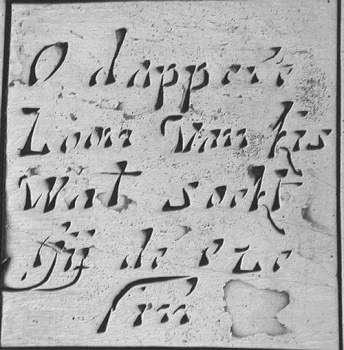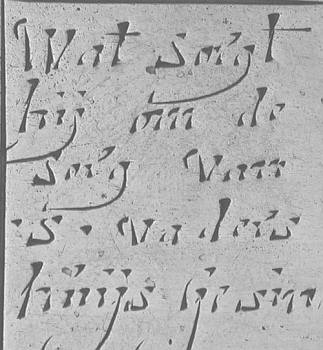by Fredric
Sinfield
|
click on images to enlarge
A TOBACCO BOX

 The unmarked silver box, 155x60x35mm and weighing 200 grams
probably dates from the last decade of the 18th century.
The unmarked silver box, 155x60x35mm and weighing 200 grams
probably dates from the last decade of the 18th century.
On the lid is engraved scene featuring a bishop wearing a mitre
blessing a kneeling supplicant with two supporters and two
onlookers.
Either side are two panels with a rhyme in Dutch that reads
"O dappere zoon van Kis,
Wat soekt gij de ezelin
Wat sorgt hij om de sorg
van 's vaders huijsgesin"
This text relates to the story of Saul, son of Kis about to set
off in search for the missing asses as told in the First Book of
Samuel, chapter 9. Saul, who was jealous of his son-in-law
David, became the first king of the Israelites but fell in
battle against the Philistines. On the sides, both front and
back are six panels each depicting and naming the twelve
Apostles.
The engraving on the base has a central figure in front of a
very large figure lying down and nearby three onlookers. There
are two panels of text that are partially illegible referring to
David slaying Goliath as told in the First Book of Samuel,
chapter 10.
This killing of the giant was the cause of the jealousy that
forced David to become an outlaw until after Saulís death when
he became the chosen king of Israel.
This base panel probably contains a lightly veiled reference to
one of two events of the 1780ís that occurred in the Netherlands.
There was the attempted coup by the Patriots against the
stadtholder Willem V in 1785 or the revolt against Austriaís
rule of the Southern Netherlands at the Battle of Turnhout in
1789.
The coup attempt had it beginnings in 1781 with publication of
the pamphlet Aan het Volk van Nederland addressed to the People
of the Netherlands containing the political program of a group
of reformers called the Patriots. At the congress, to popularise
the ideas of the Enlightenment, there were demands for a new
constitution.
In 1786, the group seized control the administration of Utrecht
and the following year saw the defeat of the troops of the
stadholder. Then the take over of the administration of
Amsterdam and Rotterdam with Utrecht declared the capital of the
Dutch Republic. However, 20,000 Prussian troops invaded in 1787,
met little resistance and occupied Amsterdam thus ending the
Patriot Revolution.
The dissidents fled to France in 1795 but returned to fight
resulting in the French invading the Netherlands and
establishing the Batavian Republic in 1795. William V sought
safety in England and died in exile in Brunswick in 1806.
The other event was in 1789 at Turnhout in the southern
Netherlands where a volunteer army defeated the Austrians forces
by luring them into the city, ambushing and forcing withdrawal
of the Austrians to Luxemburg. The bitterness of this defeat
lead to the death of Emperor Joseph II in 1790.
Acknowledgement to Casper Staal, curator of Museum
Catharijneconvent, Utrecht and Janjaap Luijt for their
invaluable assistance
|
Fredric Sinfield
- 2007 -
|
|
 ASSOCIATION OF SMALL COLLECTORS OF ANTIQUE SILVER
ASSOCIATION OF SMALL COLLECTORS OF ANTIQUE SILVER ASSOCIATION OF SMALL COLLECTORS OF ANTIQUE SILVER
ASSOCIATION OF SMALL COLLECTORS OF ANTIQUE SILVER